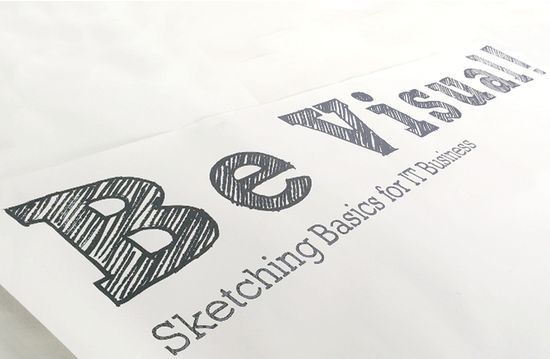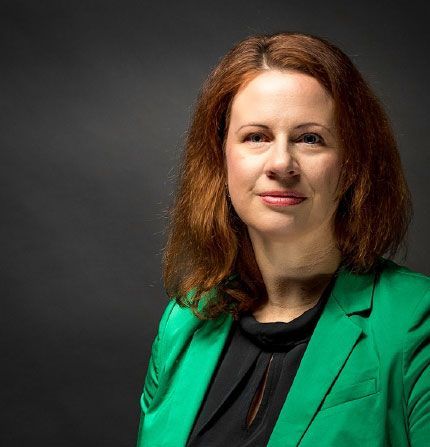
Join this free, online openSAP course ‘Be Visual! Sketching Basic for IT Business’ and start learning the very basics of sketching. By applying the practice-oriented tips and tricks in this course, you’ll gain the confidence to present your ideas visually.
This course was retired in October 2023.
Please note: There is a more recent version of this course: Be Visual! Sketching Basics for IT Business (Edition Q4/2022).
Kurssprache: English
Kursinformationen

This course was retired in October 2023.
Course Summary
Sketching helps you to communicate abstract ideas and transform them into tangible artifacts that can be further explored and validated. With their low fidelity, sketches provide room for interpretation and invite discussion. Sketches also are a starting point for iteration.
Many companies, such as Google, have come to recognize sketching as a powerful communication tool that can be used not only within a team, but also when collaborating with customers.
The openSAP course ‘Be Visual! Sketching Basic for IT Business’ starts with the very basics of sketching. By applying the practice-oriented tips and tricks in this course, you’ll gain the confidence to present your ideas visually. From basic shapes and handwriting to creating storyboards and screen sketches, you’ll be able to use these techniques whether at a flipchart, whiteboard, or at your desk.
Here is what some participants are saying about the course:
”just to let you know I loved everything, it has all been really really useful and beautifully explained and presented by everyone! I really enjoyed these 4 weeks, I will be practicing on my own, hopefully publishing a comic book in the future (or not!! :-) )...“ Read the original post
“Great course! Very well structured. Loved all of the excercises...” Read the original post
“I like the examples and explanations. It made starting with sketching really easy for me, although I always thought I couldn't draw at all...“ Read the original post
Course Characteristics
- Starting from: Tuesday, November 05, 2019, 09:00 UTC. (What does this mean?)
- Duration: 1 preparation week (20 min - 1 hour) and 4 content weeks (2-3 hours per week)
- Course closure: Wednesday, December 11, 2019, 09:00 UTC
- Course language: English
- How is an openSAP course structured?
Course Content
Preparation week: Get your materials ready
Week 1: Sketching Basics and Writing
Week 2: Flow Charts and Screen Sketches
Week 3: Materials and Objects
Week 4: People and Storyboards
Target Audience
- Everyone who wants to gain confidence in communicating visually. The content is related to the IT business, but valid for all kinds of disciplines.
Course Requirements
- There are no prerequisites.
Previous Versions of This Course:
Previous versions of this course are available here:
Be Visual! Sketching Basics for IT Business (Edition Q1/2017) (February 20 through March 21, 2017)
Be Visual! Sketching Basics for IT Business (Edition Q3/2017) (September 6 through October 12, 2017)
Be Visual! Sketching Basics for IT Business (Edition Q1/2018) (February 6 through March 14, 2018)
Be Visual! Sketching Basics for IT Business (Edition Q3/2018) (September 11 through October 17, 2018)
Be Visual! Sketching Basics for IT Business (Edition Q1/2019) (March 5 through April 10, 2019)
Lernmaterial
Course content no longer available
Material and Settings
Week 1:
Sketching Basics and WritingWeek 2:
Flow Charts and Screen SketchesWeek 3:
Materials and ObjectsWeek 4:
People and StoryboardsI Like, I Wish:
We Love Your Feedback … And Want More
Für diesen Kurs einschreiben
Lernende
Bewertungen
Der Kurs wurde mit durchschnittlich 4.52 Sternen bei 260 abgegebenen Stimmen bewertet.
Anforderungen für Leistungsnachweise
- Den Leistungsnachweis erhält, wer in der Summe aller benoteten Aufgaben mindestens 50% der Höchstpunktzahl erreicht hat.
- Die Teilnahmebestätigung erhält, wer auf mindestens 50% der Kursunterlagen zugegriffen hat.
Mehr Informationen finden Sie in den Richtlinien für Leistungsnachweise.
Dieser Kurs wird angeboten von

Former Director Design and POC Development
Martina Schuh led an innovation team of developers, designers, and other roles. The team shaped the SAP Fiori experience by running projects that enable SAP Fiori development and pushed the boundaries of the SAP Fiori experience itself.
Since 2005, Martina has been driving the topic of Design Thinking at SAP. She has applied the approach to software development and strategy projects, and has co-lead the development of the Design Thinking curriculum at SAP.
Whenever Martina works with teams, customers, or colleagues, she encourages everybody to share their ideas visually.

Senior User Experience Designer
As a member of the UX team at SAP, Johanna Wittig focuses on developing new ideas and concepts for interacting with business applications.
Throughout her professional career, she has worked in multidisciplinary teams with the aim of encouraging a multidisciplinary approach and strengthening a productive exchange across disciplines. Time and again, she has experienced that sketches are an excellent medium to reach this goal.
Since joining SAP, Johanna has been driving several teaching formats for visual communication.

Development Architect
Jörg Göppert is a member of a multidisciplinary team that focuses on innovations around SAP Fiori.
The proof-of-concept projects he works on use Design Thinking. This highly iterative approach requires a very open and agile communication between disciplines. Along the whole process, he uses and promotes sketching techniques such as storyboarding and screen sketching in the design phase, and technical architecture sketches in the development phase.
Jörg believes sketching is a very good tool to build up a common understanding within teams.

Ingo Rues is a strategic design consultant currently focusing on envisioning and materializing the next level user experience. He has been innovating, creating, and designing concepts with users’ needs in mind for many years.
Ingo is also a blacksmith, and has built many objects made of metal. This is where his passion for treating material correctly originates from. Professional handling of material is the essential first step towards a great outcome.
When it comes to sketching, Ingo always pays special attention to using materials that best suit the situation and purpose.

User Experience Design Expert
Tatjana Borovikov is a design professional with over thirteen years of hands-on experience in diverse industries such as education, finance, marketing, and manufacturing. She has been involved in projects around interaction and interface design, visual design, responsive design, and product design.
Since 2006, Tatjana has been teaching and applying Design Thinking in numerous innovation projects at SAP, leading design and research efforts.
When working on concepts and scenarios for business applications, she invites all team members to use sketching for clear and direct communication.

Design Strategist and Design Thinking Expert
Anja Fehlau is a design professional with 15 years of experience in IT research and innovation. She has been involved in diverse projects ranging from designing new applications and user experiences, through design enablement topics, to creating spaces and processes for creative collaboration.
Anja has significantly influenced Design Thinking at SAP since it started in 2005, and has facilitated numerous workshops, run projects, and trained people around the globe.
When working in teams, Anja uses storyboarding as a key tool to bring in the user perspective while developing new concepts. It’s a visual language that everyone understands.